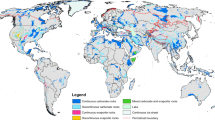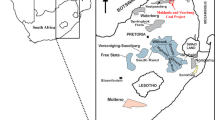Abstract—
The results of the study of the carbonate profiles of soils in the western (Cis-Baikal) and eastern (the Selenga middle mountains) Baikal region are presented. There is a similarity in their structure: numerous CaCO3 maxima in the soil profiles are typical, which is associated with the repeated redistribution of carbonates during different stages of pedogenesis. The carbonate profile of soils in the Baikal region is relatively ancient (the youngest accumulations date back to the Middle Holocene) and a rather conservative formation that does not undergo any noticeable rearrangements under modern climatic conditions. The accumulations of secondary carbonates are localized in the carbonate-accumulative horizons of the modern surface soils and buried Kargin (MIS-3) soils and Holocene soils. The exception is hypocoatings that are often found beyond the indicated horizons, which is associated with a more active redistribution of carbonates within the root system of vegetation. The solid-phase effect of carbonatization (carbonate neoformations) is observed in the study area mainly in the soils formed on calcareous rocks and products of their redeposition and does not depend on the type of soil and the nature of the growing vegetation. Based on the analysis of the composition of stable carbon and oxygen isotopes in secondary carbonate accumulations, it was found that carbonate precipitation in soils of the Cis-Baikal region occurs during the degassing of soil solutions in the course of freezing–thawing cycles, dynamic increase and decrease in the soil biological activity, and alternation of the soil moistening with snowmelt and rainwater with its subsequent freezing that can take place in spring and autumn seasons. Under these conditions, atmospheric CO2 has the main influence on the isotopic composition of carbon in pedogenic carbonates; the isotopic composition of oxygen is controlled by the fractionation of isotopes upon freezing of the soil solutions. Secondary carbonate accumulations in the Selenga middle mountains are formed during the soil drying as a result of active water consumption for plant transpiration, which is most pronounced in the first half of summer.





Similar content being viewed by others
REFERENCES
A. L. Aleksandrovskii, “Environmental records in soils of the Holocene,” in Soil Memory: Soil as a Memory of the Biosphere–Geosphere–Anthroposphere Interactions (LKI, Moscow, 2008), pp. 75–105.
E. V. Arinushkina, Manual on the Chemical Analysis of Soils (Moscow State Univ., Moscow, 1970), pp. 166–167.
V. I. Volkovintser, Steppe Cryoarid Soils (Nauka, Novosibirsk, 1978) [in Russian].
G. A. Vorob’eva, “Evolution of soils of foothills and low mountains in the south of Central Siberia in the Holocene,” in Evolution of Soils and Soil Cover: Theory, Diversity of Natural Evolution, and Anthropogenic Transformation of Soils (GEOS, Moscow, 2015), pp. 686–703.
Geology of the Soviet Union, Vol. 17: Irkutsk Oblast (Gosgeoltekhizdat, Moscow, 1962) [in Russian].
Global and Regional Climate and Environment in the Late Cenozoic in Siberia (Siberian Branch, Russian Academy of Sciences, Novosibirsk, 2008) [in Russian].
V. A. Golubtsov, Yu. V. Ryzhov, and D. V. Kobylkin, Pedogenesis and Sedimentation in the Selenga Middle Mountains in the Late Glacial Period and Holocene (Institute of Geography, Siberian Branch, Russian Academy of Sciences, Irkutsk, 2017) [in Russian].
V. A. Golubtsov, O. S. Khokhlova, and A. A. Cherkashina, “Carbonate rhizoliths in dune sands of the Belaya River valley (Upper Angara region),” Eurasian Soil Sci. 52, 83–93 (2019). https://doi.org/10.1134/S1064229319010034
V. A. Golubtsov, A. A. Cherkashina, K. E. Pustovoytov, and K. Stahr, “Stable carbon and oxygen isotopes in pedogenic carbonate coatings of chernozems in the southern Cis-Baikalia as indicators of local environmental changes,” Eurasian Soil Sci. 47, 1015–1026 (2014).
L. V. Danko, E. B. Bezrukova, and L. A. Orlova, “Reconstructing the development of the geosystems of the Primorsky Range during the latter half of the Holocene,” Geogr. Nat. Resour. 30, 246–252 (2009).
L. V. Dan’ko, S. B. Kuz’min, and V. A. Snytko, “Baikal coastal geosystems and their landscape-geochemical structure,” Geogr. Prirod. Resur., No. 3, 45–51 (2000).
Salt-Affected Soils of Russia (Akademkniga, Moscow, 2006) [in Russian].
N. I. Karnaukhov and K. V. Morozova, “Cryogenic accumulation of carbonate lime in soils of the south of Central and Eastern Siberia,” in Permafrost and Soils, No. 3: Genesis, Geography, and Classification of Permafrost Soils (Yakut Branch, Siberian Branch, Academy of Sciences of USSR, Yakutsk, 1974), pp. 135–140.
I. V. Kovda and O. S. Khokhlova, “Carbonate profile of soils,” in Evolution of Soils and Soil Cover: Theory, Diversity of Nature Evolution and Anthropogenic Transformation of Soils (GEOS, Moscow, 2015), pp. 140–158.
A. A. Kozlova and A. P. Makarova, Ecological Factors of Pedogenesis in the Southern Cis-Baikal Region (Irkutsk State Univ., Irkutsk, 2012), pp. 86–96.
V. T. Kolesnichenko, Zalarinka Winter Wheat in Irkutsk Oblast (Promekobezopastnost, Moscow, 2003) [in Russian].
S. S. Kostrova, H. Meyer, P. E. Tarasov, E. V. Bezrukova, B. Chapligin, A. Kossler, L. A. Pavlova, and M. I. Kuzmin, “Oxygen isotope composition of diatoms from sediments of Lake Kotokel (Buryatia),” Russ. Geol. Geophys. 57, 1239–1247 (2016). https://doi.org/10.1016/j.rgg.2016.08.009
V. A. Kuz’min, Soils of the Cis-Baikal Region and Northern Transbaikalia (Nauka, Novosibirsk, 1988) [in Russian].
N. A. Logachev, T. K. Lomonosova, and V. M. Klimanova, Cenozoic Deposits of the Irkutsk Amphitheater (Nauka, Moscow, 1964) [in Russian].
O. V. Makeev, Soddy Taiga Soils of the South of Central Siberia: Genesis, Properties, and Rational Use (Buryat. Knizhn. Izd., Ulan-Ude, 1959) [in Russian].
Highlands of Cis-Baikal and Transbaikalia (Nauka, Moscow, 1974) [in Russian].
B. V. Nadezhdin, Lena-Angara Forest-Steppe (Academy of Sciences of USSR, Moscow, 1961) [in Russian].
Scientific Reference Handbook on Climate in the USSR, Ser. 3: Long-Term Data, Parts 1–6, No. 23: Buryat ASS-R, Chita Oblast (Gidrometeoizdat, Leningrad, 1989) [in Russian].
Scientific Reference Handbook on Climate in the USSR, Ser. 3: Long-Term Data, Parts 1–6, No. 22: Irkutsk Oblast and Western Part of Buryat ASSR (Gidrometeoizdat, Leningrad, 1991) [in Russian].
I. V. Nikolaev, Soils of Irkutsk Oblast (Irkutsk, 1949) [in Russian].
N. A. Nogina, Soils of Transbaikalia (Nauka, Moscow, 1964) [in Russian].
Highlands and Lowlands of Eastern Siberia (Nauka, Moscow, 1971) [in Russian].
A. A. Rode, Fundamentals of the Theory on Soil Moisture, Vol. 2: Study Methods of Water Regime of Soils (Gidrometeoizdat, Leningrad, 1969) [in Russian].
V. A. Snytko and L. V. Dan’ko, “Soil-geochemical features of ecotone of taiga and steppe in the Olkhon region,” Geogr. Prirod. Resur., No. 1, 59–65 (2004).
T. A. Sokolova, E. K. Kulagina, V. A. Pavlov, and V. V. Tsarevskii, “Comprehensive study of soil carbonates,” in Modern Physical and Chemical Methods of Soil Studies (Moscow State Univ., Moscow, 1987), pp. 171–194.
K. A. Ufimtseva, Steppe and Forest-Steppe Soils of the Buryat ASSR (Academy of Sciences of USSR, Moscow, 1960) [in Russian].
N. A. Khotinskii, Holocene of Northern Eurasia (Nauka, Moscow, 1977) [in Russian].
G. Barta, B. Bradák, A. Novothny, A. Markó, J. Szeberényi, K. Kiss, and J. Kovács, “The influence of paleogeomorphology on the stable isotope signals of paleosols,” Geoderma 330, 221–231 (2018). https://doi.org/10.1016/j.geoderma.2018.05.033
R. L. Baumhardt and R. J. Lascano, “Physical and hydraulic properties of a calcic horizon,” Soil Sci. 155, 368–375 (1993). https://doi.org/10.1097/00010694-199306000-00002
P. W. Birkeland, Soils and Geomorphology (Oxford University Press, New York, 1999).
C. Bowsher, M. Steer, and A. Tobin, Plant Biochemistry (Garland, New York, 2008).
D. O. Breecker, Z. D. Sharp, and L. D. McFadden, “Seasonal bias in the formation and stable isotopic composition of pedogenic carbonate in modern soils from central New Mexico, USA,” Geol. Soc. Am. Bull. 121 (3–4), 630–640 (2009). https://doi.org/10.1130/B26413.1
P. L. Broughton, “Environmental Implication of competitive growth fabrics on stalactitic carbonate,” Int. J. Speleol. 13, 31–41 (1983).
T. Cerling, “The stable isotopic composition of soil carbonate and its relationship to climate,” Earth Planet. Sci. Lett. 71, 229–240 (1984).
T. E. Cerling and J. Quade, “Stable carbon and oxygen isotopes in soil carbonates,” in Climate Change in Continental Isotopic Records, Geophysical Monograph Series vol. 78 (American Geophysical Union, Washington, DC, 1993), pp. 217–231.
Chadwick O.A. and Graham, R.C. “Pedogenic processes,” in Handbook of Soil Science (CRC Press, Boca Raton, 2000), pp. 41–75.
M.-A. Courty, C. Marlin, L. Dever, P. Tremblay, and P. Vachier, “The properties, genesis and environmental significance of calciticpendents from the High Arctic (Spitsbergen),” Geoderma 61, 71–102 (1994).
M. Egli and P. Fitze, “Quantitative aspects of carbonate leaching of soils with differing ages and climates,” Catena 46, 35–62 (2001). https://doi.org/10.1016/S0341-8162(01)00154-0
H. Eswaran, P. F. Reich, J. M. Kimble, F. H. Beinroth, E. Padmanabhan, and P. Moncharoen, “Global carbon sinks,” in Global Climate Change and Pedogenic Carbonates (CRC Press, Boca Raton, FL, 2000), pp. 15–26.
L. H. “Gile, A classification of ca horizons in soils of a desert region, Dona Ana County, New Mexico,” Soil Sci. Soc. Am. J. 25, 52–61 (1961). https://doi.org/10.2136/sssaj1961.03615995002500010024x
N. Kurita, A. Numaguti, A. Sugimoto, K. Ichiyanagi, and N. Yoshida, “Relationship between the variation of isotopic ratios and the source of summer precipitation in eastern Siberia,” J. Geophys. Res. D: Atmos. 108 (11), 4339 (2003). https://doi.org/10.1029/2001JD001359
G. M. Marion, D. S. Introne, and K. van Cleve, “The stable isotope geochemistry of CaCO3 on the Tanana River floodplain of interior Alaska, U.S.A.: composition and mechanisms of formation,” Chem. Geol. 86, 97–110 (1991).
C. H. Monger, D. R. Cole, B. J. Buck, and R. A. Gallegos, “Scale and the isotopic record of C4 plants in pedogenic carbonate: from the biome to the rhizosphere,” Ecology 90 (6), 1498–1511 (2009).
L. C. Nordt, C. T. Hallmark, L. P. Wilding, and T. W. Boutton, “Quantifying pedogenic carbonate accumulations using stable carbon isotopes,” Geoderma 82, 115–136 (1998). https://doi.org/10.1016/S0016-7061(97)00099-2
N. A. Peters, K. W. Huntington, and G. D. Hoke, “Hot or not? Impact of seasonally variable soil carbonate formation on paleotemperature and O-isotope records from clumped isotope thermometry,” Earth Planet. Sci. Lett. 361, 208–218 (2013). https://doi.org/10.1016/j.epsl.2012.10.024
K. Pustovoytov, K. Schmidt, and H. Taubald, “Evidence for Holocene environmental changes in the northern Fertile Crescent provided by pedogenic carbonate coatings,” Quat. Res. 67, 315–327 (2007). https://doi.org/10.1016/j.yqres.2007.01.002
J. Quade, T. Cerling, and J. Bowman, “Systematic variations in the carbon and oxygen isotopic composition of pedogenic carbonate along elevation transects in the southern Great Basin, United States,” Geol. Soc. Am. Bull. 101, 464–475 (1989).
J. Quade, C. Garzione, and J. Eiler, “Paleoelevation reconstruction using pedogenic carbonates,” Rev. Miner. Geochem. 66, 53–88 (2007). https://doi.org/10.2138/rmg.2007.66.3
G. J. Retallack, “Pedogenic carbonate proxies for amount and seasonality of precipitation in paleosols,” Geology 33, 333–336 (2005). https://doi.org/10.1130/G21263.1
D. L. Royer, “Depth to pedogenic carbonate horizon as a paleoprecipitation indicator?” Geology 27, 1123–1126 (1999). https://doi.org/10.1130/0091-7613(1999)027b1123:DTPCHAN2.3.CO;2
Statistical Treatment of Data on Environmental Isotopes in Precipitation, Technical Reports Series no. 331 (International Atomic Energy Agency, Vienna, 1992), p. 240.
T. Vogt, “Cryogenic physicochemical precipitations: iron, silica, calcium carbonate,” Permafrost Periglacial Process. 1, 283–293 (1991).
T. Vogt and A. E. Corte, “Secondary precipitates in Pleistocene and present cryogenic environments (Mendoza Precordillera, Argentina, Transbaikalia, Siberia, and Seymour Island, Antarctica),” Sedimentology 43, 53–64 (1996).
T. Vogt, N. Clauer, and I. Techer, “The glaciogenic origin of the Pleistocene calcareous dust in Argentina on the basis of field, mineralogical, textural, and geochemical analyses,” Quat. Res. 91 (1), 218–233 (2018). https://doi.org/10.1017/qua.2018.74
K. Zamanian, K. Pustovoytov, and Y. Kuzyakov, “Pedogenic carbonates: forms and formation processes,” Earth-Sci. Rev. 157, 1–17 (2016). https://doi.org/10.1016/j.earscirev.2016.03.003
Funding
The study was performed within the framework of the research program of the Sochava Institute of Geography, Siberian Branch of the Russian Academy of Sciences (no. 0347-2016-0002) and partly supported by the Russian Foundation for Basic Research (project nos. 17-04-00092 and 17-04-01526). Micromorphological studies were carried out within the framework of the state assignment AAAA-A18-118013190175-5.
Author information
Authors and Affiliations
Corresponding author
Additional information
Translated by D. Konyushkov
Rights and permissions
About this article
Cite this article
Golubtsov, V.A., Cherkashina, A.A. & Khokhlova, O.S. Carbonate Profile of Soils in the Baikal Region: Structure, Age, and Formation Conditions. Eurasian Soil Sc. 52, 1515–1532 (2019). https://doi.org/10.1134/S1064229319120056
Received:
Revised:
Accepted:
Published:
Issue Date:
DOI: https://doi.org/10.1134/S1064229319120056




